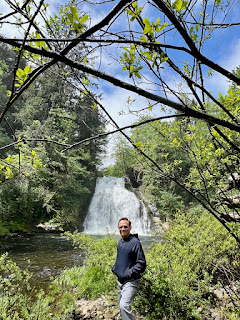We started our sightseeing with the Louis and Clark National Historical Park which was closed when we got there on day 1.
President Thomas Jefferson had for years been fascinated by the vast and virtually unknown territory west of the Mississippi River, and in June 1803 he announced plans to send an exploratory party overland to the Pacific. He had chosen Lewis to head it, and Lewis selected Clark, his friend and former commanding officer to share the responsibilities. They were to explore the Missouri River to its source, then to establish the most direct water route to the Pacific, making scientific and geographic observations along the way. They were also to learn what they could about the Native American tribes they encountered and impress them with the technology and authority of the United States. The explorers started up the Missouri River from near St. Louis on May 14, 1804. After a tedious journey of five months, they wintered at Fort Mandan. In April 1805 the Corps of Discovery left Fort Mandan and followed the Missouri and its upper branches into an unknown world. Along the Lemhi River, in what is now Idaho, Sacagawea's people provided horses and a guide for the grueling trip over the Continental Divide. In November 1805, after some 600 miles of water travel down the Clearwater, Snake, and Columbia rivers, they finally sighted the Pacific. Within 10 days of arriving on the coast, Lewis and Clark decided to leave their storm-bound camp on the north shore and cross the river, where elk were reported to be plentiful. Lewis, with a small party, scouted ahead and found a "most eligible" site for winter quarters. On December 10, 1805, the men began to build a fort about two miles up the Netul River (now Lewis and Clark River). By Christmas Day they were under shelter. They named the fort for the friendly local native american tribe, the Clatsop. It would be their home for the next three months.
In the park, there is Fort Clatsop which was the encampment of the Lewis and Clark Expedition during the winter of 1805–1806. The original Fort Clatsop decayed in the wet climate of the region but was reconstructed for the sesquicentennial in 1955 from sketches in the journals of William Clark. The replica lasted for fifty years, but was severely damaged by fire in early October 2005, weeks before Fort Clatsop's bicentennial. A new replica, more rustic and rough-hewn, was built by about 700 volunteers in 2006; it opened with a dedication ceremony that took place on December 9.
Then, we hiked on the beautiful Netul River Trail (1 mile trail) to learn about the history of logging and commerce along the Lewis and Clark River. It was an easy and pleasant hike.After that we drove to the nearby Young River Falls to see the beautiful waterfalls close to Astoria. When we got there, there was nobody else and we had the whole falls by ourselves. It was a peaceful and relaxing moment for us to enjoy. In addition, there is a beautiful but strange tree next to it and we stayed there for quite a while to take photos. Then, we drove on the Astoria-Megler Bridge to visit the Fort Columbia Historical State Park in Washington State. Astoria-Megler Bridge was built to withstand Pacific storms with wind speeds that reach some 150 miles (240 km) per hour and river currents that can hit speeds of 9 miles (14 km) per hour. The Astoria Bridge was meant to replace ferry service that was inefficient and subject to disruptions during bad weather. The bridge stretches 4.1 miles from Astoria, Oregon, across the mouth of the Columbia River to Point Ellice, Washington, and contains the longest continuous three-span through-truss in the world.Fort Columbia State Park is considered one of the most intact historic coastal defense sites in the U.S. In addition to its historical significance, the area offers bird watching, miles of forested hiking trails and secluded beaches. The park grounds feature three artillery batteries and two coastal artillery guns.
The wind was too strong for us there, therefore, we just wandered a little bit around artillery guns and then drove back to the hotel.









No comments:
Post a Comment